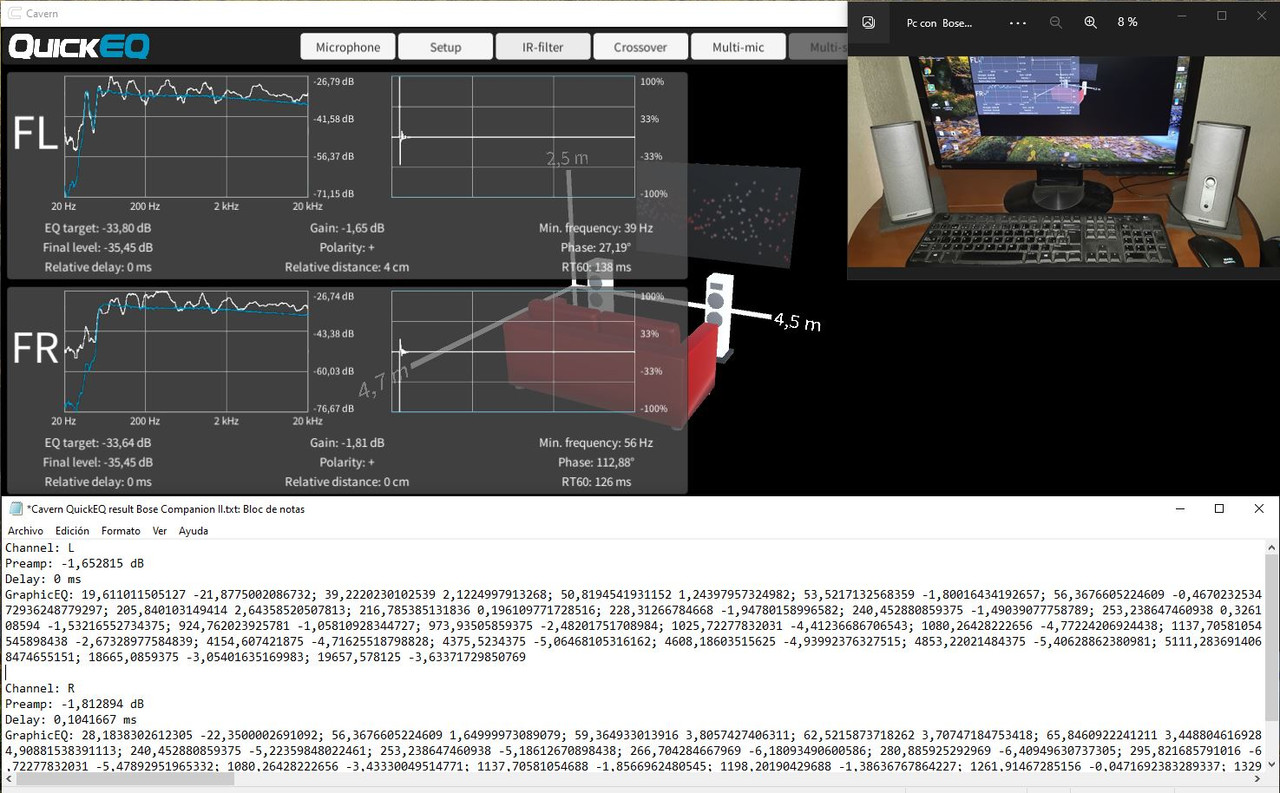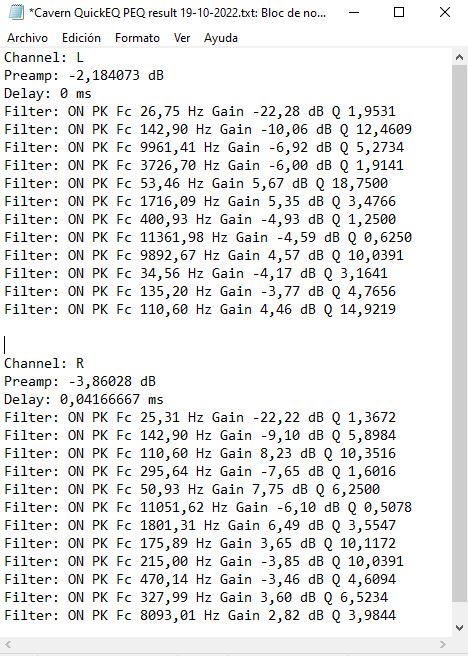The closest you can get is my Equalizer APO to FIR software, that can be imported to any convolution plugin. Sadly it's not that fast of a workflow.So I've looked everywhere and couldn't find a plugin that allows unlimited "point to point" type of equalization as APO's Graphic EQ does. As a DAW addition.
-
Welcome to ASR. There are many reviews of audio hardware and expert members to help answer your questions. Click here to have your audio equipment measured for free!
You are using an out of date browser. It may not display this or other websites correctly.
You should upgrade or use an alternative browser.
You should upgrade or use an alternative browser.
EQ Software for Windows, Linux, macOS, iOS/iPadOS and Android.
- Thread starter Doodski
- Start date
Thank you very much for putting this free program for Windows for everyone.Hi, I'd also like to show off my creation: a free and open source EQ software for Windows with a single click feature for Equalizer APO, completely customizable crossover, multi-mic and multi-sub support, Atmos playback with EQ, making ported subs sound like sealed ones, and many more features: http://cavern.sbence.hu/cavern/quickeq.php
Supports Equalizer APO, MiniDSP, MultEQ-X, StormAudio, and Behringer.
This one is completely built on user feedback, so if you'd like to see anything, just reach out to me.
Is there a forum, tutorial where you can see how to use it?
written with translator
Greetings
Yes, here it is, and this is the advanced one.Is there a forum, tutorial where you can see how to use it?
Yes, here it is, and this is the advanced one.
Edited:
Thanks for putting the 2 links.
I use the Pc + Equalizer APO ( REW + Umik-1) for my 5.1
I have followed the steps of this video and I have already been able to with the Bose Companion II.
What I see is that the equalizer is graphic and not parametric.

Can they be done with parametric filters?
I say this because in my particular case I equalize with APO with parametric filters using the REW RTA.
I leave you a sample of my central channel using APO with real-time parametric filters ( RTA ).
I adapt the target target to my liking but always using pink noise + RTA
written with translator
Greetings
Last edited:
Use the "Export as peaking EQ" option. However, this has lower precision and worse sound quality.Can they be done with parametric filters?
So, as you can see in the capture that I have posted of the equalization, are they only graphic filters or are there also mixed parametric ones?Use the "Export as peaking EQ" option. However, this has lower precision and worse sound quality.
I see that it says for example:
GraphicEQ and hence my confusion:
I give an example of the first filter of the Channel L
19.611011505127 -21,8775002086732; and I would say that it is a parametric filter

Thanks for the clarifications.
Greetings
They are only graphic, these are their points (frequency-gain pairs). Parametric can only be exported with the "Export as peaking EQ" option. Itt will have up to 20 filters per channel, each in a new line. You might have to click the more button on the export tab for it to appear.So, as you can see in the capture that I have posted of the equalization, are they only graphic filters or are there also mixed parametric ones?
I already have it clear, thanks. What surprises me is that you say that with parametric filters you do not get such a precise and good sound.They are only graphic, these are their points (frequency-gain pairs). Parametric can only be exported with the "Export as peaking EQ" option. Itt will have up to 20 filters per channel, each in a new line. You might have to click the more button on the export tab for it to appear.
Do the PEQs that your program applies in the mid-high zone have a fairly narrow Q?
I use PEQS and I never use a narrow Q in mid-high.
I hope you understand what I say, since I use a translator.
Greetings
No, it only depends on what creates the flattest result. Qs can range from 0 to 20.Do the PEQs that your program applies in the mid-high zone have a fairly narrow Q?
Parametric EQ breaks the phase alignment if frequencies and Qs are not uniform (so always). Graphic (FIR) does not, and can even fix bad phase.What surprises me is that you say that with parametric filters you do not get such a precise and good sound.
Thank you for the courtesy in responding.No, it only depends on what creates the flattest result. Qs can range from 0 to 20.
Parametric EQ breaks the phase alignment if frequencies and Qs are not uniform (so always). Graphic (FIR) does not, and can even fix bad phase.
About the IR and FIR filters I don't want to disagree in this thread, I can simply say that I have done 2 equalizations:
The EQ in each channel with graphic filters has from 100 to 120 filters and the one made with parametrics in my case only has 12 filters per channel.
I am clear that it may be because of the target that I have chosen (it only plays up to 11Khz) to test and that I have just started with Cavern QuickEQ, even so I do not see the comparison as appropriate and objective since 100-120 filters vs 12 there is no color.

written with translator
Greetings
AudioScience Enthusiast
Active Member
- Joined
- Nov 18, 2022
- Messages
- 243
- Likes
- 78
What a great list!
I am currently on MacOS, is it still true that there are no apps today that can do both system hosting and exclusive mode?
It seems like Roon (a paid service) is the only way to get both?
I am currently on MacOS, is it still true that there are no apps today that can do both system hosting and exclusive mode?
It seems like Roon (a paid service) is the only way to get both?
Does anybody know a good VST host for Windows, so I can load my Pro Q3 to run in the background the same way Sonarworks do?
I can vouch for @mitchco's Hang Loose Convolver, bonus - you can switch between 6 different filters in real time for comparison. Best to check if your particular VST works with it well in Windows though.
dasdoing
Major Contributor
Does anybody know a good VST host for Windows, so I can load my Pro Q3 to run in the background the same way Sonarworks do?
it works in Equalizer-APO
This is exactly what I was looking for! I can even create a plugin chain. Thank you!
Does anyone know of a free macOS option that can do parametric EQ (and ideally import from a text file generated from REW) like Equalizer APO?
I have heard that SoundSource can do this, but it costs $41USD.
I found that BlackHole and AUNBandEQ can be used as per this guide or this post and are free but when I try to put in the filter parameters the Q value is in 'octive' so then I would need to convert the Q value into 'octive' using this table?

(I also got confused by this discussion and if 1,40845 was pertinent to me)
The BlackHole / AUNBandEQ method also seems semi cumbersome but if that is the only free way to get these filters up and running on a mac then I guess its worth figuring out the Q to octave conversion.
Does anyone have other free ideas?
Or thoughts on how change from specific Q values from REW generated filters to the needed 'octive' scale?
Thanks!
I have heard that SoundSource can do this, but it costs $41USD.
I found that BlackHole and AUNBandEQ can be used as per this guide or this post and are free but when I try to put in the filter parameters the Q value is in 'octive' so then I would need to convert the Q value into 'octive' using this table?
(I also got confused by this discussion and if 1,40845 was pertinent to me)
The BlackHole / AUNBandEQ method also seems semi cumbersome but if that is the only free way to get these filters up and running on a mac then I guess its worth figuring out the Q to octave conversion.
Does anyone have other free ideas?
Or thoughts on how change from specific Q values from REW generated filters to the needed 'octive' scale?
Thanks!
dasdoing
Major Contributor
Does anyone know of a free macOS option that can do parametric EQ (and ideally import from a text file generated from REW) like Equalizer APO?
I have heard that SoundSource can do this, but it costs $41USD.
I found that BlackHole and AUNBandEQ can be used as per this guide or this post and are free but when I try to put in the filter parameters the Q value is in 'octive' so then I would need to convert the Q value into 'octive' using this table?
View attachment 248328
(I also got confused by this discussion and if 1,40845 was pertinent to me)
The BlackHole / AUNBandEQ method also seems semi cumbersome but if that is the only free way to get these filters up and running on a mac then I guess its worth figuring out the Q to octave conversion.
Does anyone have other free ideas?
Or thoughts on how change from specific Q values from REW generated filters to the needed 'octive' scale?
Thanks!
the Q on my Motu device is totaly diferent. it only goes up to 3
but for bandwidth, here is a calculator: http://www.sengpielaudio.com/calculator-bandwidth.htm
antcollinet
Grand Contributor
What do you mean by both system hosting and exclusive?What a great list!
I am currently on MacOS, is it still true that there are no apps today that can do both system hosting and exclusive mode?
It seems like Roon (a paid service) is the only way to get both?
AudioScience Enthusiast
Active Member
- Joined
- Nov 18, 2022
- Messages
- 243
- Likes
- 78
The first post of this thread explains better than I can, about system hosting and exclusive modes. Is that what you are asking?What do you mean by both system hosting and exclusive?
- Thread Starter
- #460
@AudioScience Enthusiast most peeps on MacOS use this. I'm not sure if it has what you need but it might. There is a 20 minutes trial on it. If the trial period ends then restart and you get another 20 minutes etc etc...
 rogueamoeba.com
rogueamoeba.com
SoundSource - A Superior Sound Control
Access your Mac's audio devices, control per-app audio, and much more, all from the menu bar.
Similar threads
- Replies
- 42
- Views
- 3K
- Replies
- 0
- Views
- 320
- Poll
- Replies
- 18
- Views
- 2K
- Replies
- 1
- Views
- 628
- Replies
- 9
- Views
- 690